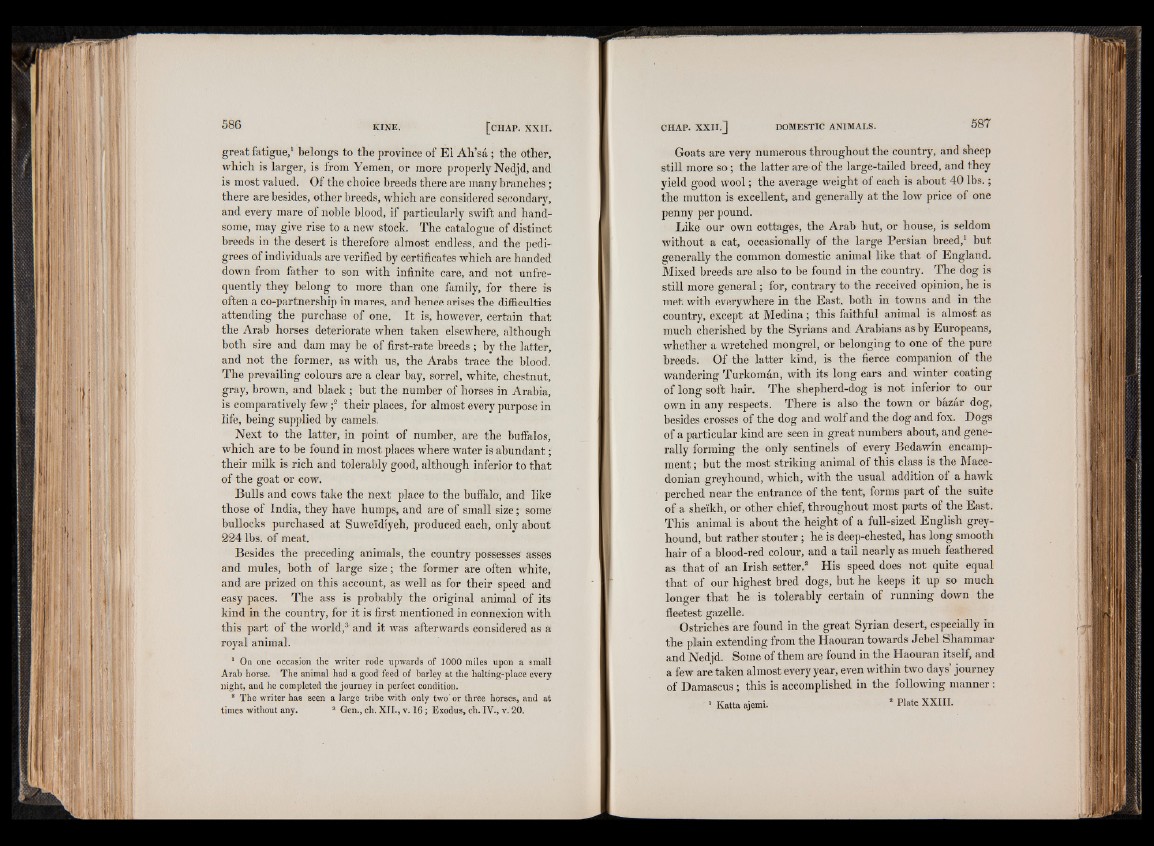
great fatigue,1 belongs to the province of El Ah’sa ; the other,
which is larger, is from Yemen, or more properly Nedjd, and
is most valued. Of the choice breeds there are many branches;
there are besides, other breeds, which are considered secondary,
and every mare of noble blood, if particularly swift and handsome,
may give rise to a new stock. The catalogue of distinct
breeds in the desert is therefore almost endless, and the pedigrees
of individuals are verified by certificates which are handed
down from father to son with infinite care, and not unfre-
quently they belong to more than one family, for there is
often a co-partnership in mares, and hence arises the difficulties
attending the purchase of one. It is, however, certain that
the Arab horses deteriorate _ _ when taken elsewhere7, althouogh
both sire and dam may be of first-rate breeds ; by the latter,
and not the former, as with us, the Arabs trace the blood.
The prevailing colours are a clear bay, sorrel, white, chestnut,
gray, brown, and black ; but the number of horses in Arabia,
is comparatively few ;2 their places, for almost every purpose in
life, being supplied by camels.
Next to the latter, in point of number, are the buffalos,
which are to be found in most places where water is abundant;
their milk is rich and tolerably good, although inferior to that
of the goat or cow.
Bulls and cows take the next place to the buffalo, and like
those of India, they have humps, and are of small size; some
bullocks purchased at Suwei'diyeh, produced each, only about
224 lbs. of meat.
Besides the preceding animals, the country possesses asses
and mules, both of large size ; the former are often white,
and are prized on this account, as well as for their speed and
easy paces. The ass is probably the original animal of its
kind in the country, for it is first mentioned in connexion with
this part of the world,3 and it was afterwards considered as a
royal animal.
1 On one occasion the writer rode upwards of 1000 miles upon a small
Arab horse. The animal had a good feed of barley at the halting-place every
night, and he completed the journey in perfect condition.
* The writer has seen a large tribe with only two' or three horses, and at
times without any. 3 Gen., ch. X II., v. 16; Exodus, ch. IV., v. 20.
Goats are very numerous throughout the country, and sheep
still more so; the latter are of the large-tailed breed, and they
yield good wool; the average weight of each is about 40 lbs.;
the mutton is excellent, and generally at the low price of one
penny per pound.
Like our own cottages, the Arab hut, or house, is seldom
without a cat, occasionally of the large Persian breed,1 but
generally the common domestic animal like that of England.
Mixed breeds are also to be found in the country. The dog is
still more general; for, contrary to the received opinion, he is
met with everywhere in the East, both in towns and in the
country, except at Medina; this faithful animal is almost as
much cherished by the Syrians and Arabians as by Europeans,
whether a wretched mongrel, or belonging to one of the pure
breeds. Of the latter kind, is the fierce companion of the
wandering Turkoman, with its long ears and winter coating
of long soft hair. The shepherd-dog is not inferior to our
own in any respects. There is also the town or bazar dog,
besides crosses of the dog and wolf and the dog and fox. Dogs
of a particular kind are seen in great numbers about, and generally
forming the only sentinels of every Bedawin encampment
; but the most striking animal of this class is the Macedonian
greyhound, which, with the usual addition of a hawk
perched near the entrance of the tent, forms part of the suite
of a sheikh, or other chief, throughout most parts of the East.
This animal is about the height of a full-sized English greyhound,
but rather stouter; he is deep-chested, has long smooth
hair of a blood-red colour, and a tail nearly as much feathered
as that of an Irish setter.2 His speed does not quite equal
that of our highest bred dogs, but he keeps it up so much
longer that he is tolerably certain of running down the
fleetest gazelle.
Ostriches are found in the great Syrian desert, especially in
the plain extending from the Haouran towards Jebel Shammar
and Nedjd. Some of them are found in the Haouran itself, and
a few are taken almost every year, even within two days’ journey
of Damascus; this is accomplished in the following manner:
1 Katta ajemi. 2 Plate XXIII.